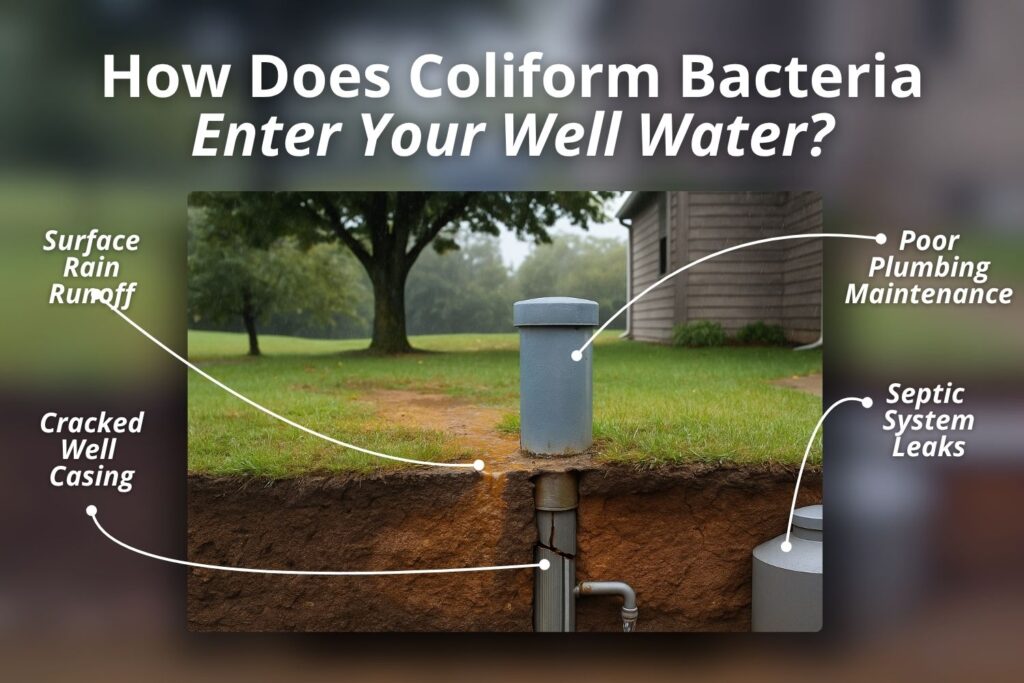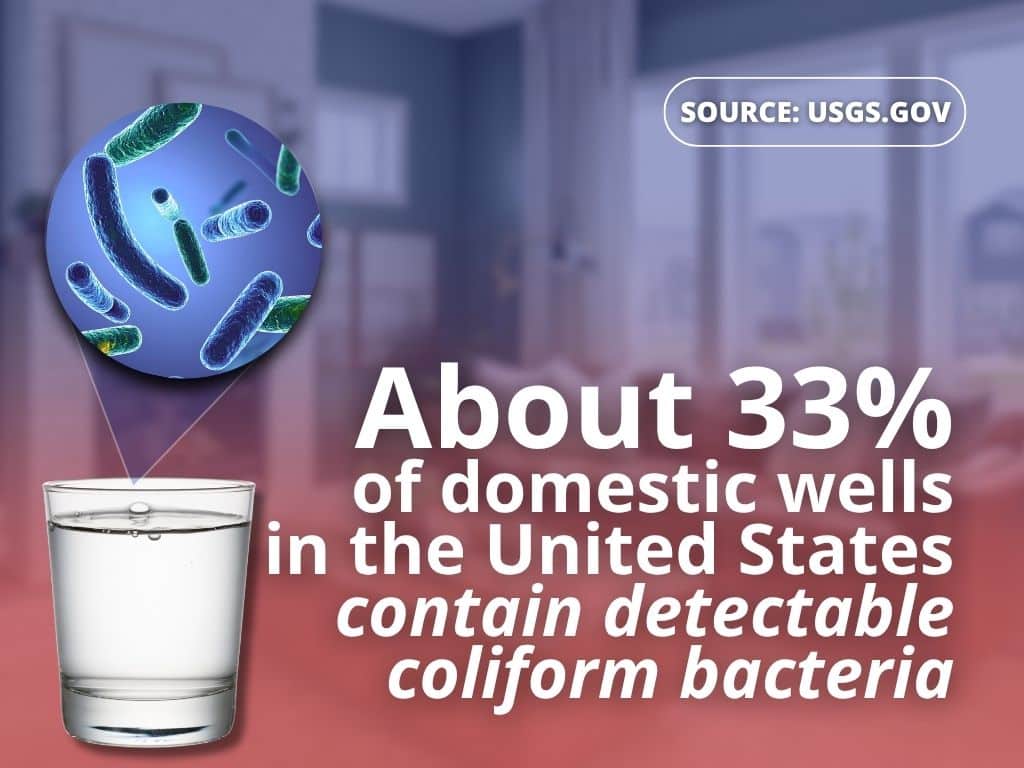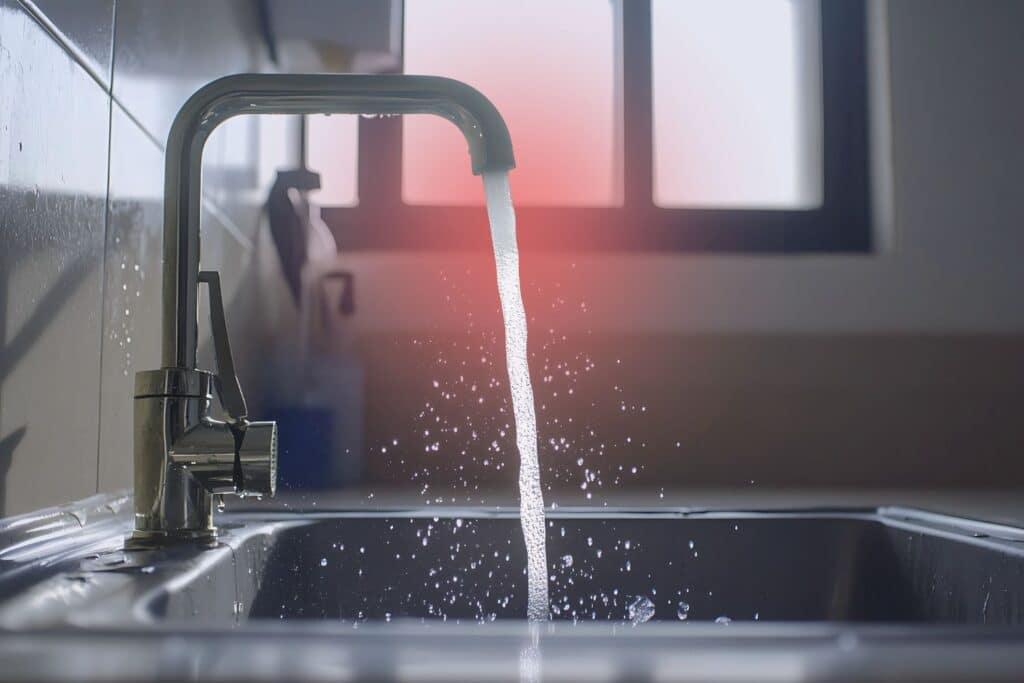If your home depends on a private well, you’re responsible for your own water quality. Unlike city water, private wells aren’t monitored by public utilities, so it’s up to the homeowner to make sure the water is safe to drink. One of the most important indicators to test for is coliform bacteria.
In North Carolina, roughly one in three residents relies on a private well for their household water. Because private wells aren’t regulated under the Safe Drinking Water Act, it’s up to homeowners to regularly test and maintain their systems.
This guide will break down what coliform bacteria are, how they get into well water, how testing for them works, and what to do if your water comes back positive.
What Are Coliform Bacteria?
Coliform bacteria are a large group of microorganisms that occur naturally in the environment. They’re commonly found in soil, vegetation, and the intestines of warm-blooded animals.
Because they’re so widespread, their presence in your well water serves as a warning sign that your water system may be exposed to contamination from outside sources.
There are three main categories you should know:
- Total Coliform: The broadest group of bacteria used as an early detection tool. Their presence means something in your well system isn’t fully sealed.
- Fecal Coliform: A subset found specifically in fecal material. Their presence indicates a direct pathway for contamination from human or animal waste.
- E. coli: A specific type of fecal coliform that can cause illness if consumed.
If total coliform bacteria show up in your water sample, you’ll need further testing to see whether fecal coliform or E. coli are also present. Even if only total coliform is detected, that’s a sign to take immediate action.
How Coliform Bacteria Get Into Well Water
There are many potential entry points for coliform bacteria, especially in older or poorly maintained wells. Here are the most common ways contamination happens.

1. Cracked or Unsealed Well Casing
Over time, concrete or steel well casings can crack or corrode. The concrete or steel casings can be impacted by soil movement, corrosion, or freezing temperatures.
Even a small fracture allows rainwater, fertilizer runoff, or animal waste to seep inside the well. Once bacteria enter, they can spread quickly throughout the water column.
2. Missing or Damaged Well Cap
A secure, intact well cap is essential. If it’s loose, broken, or missing altogether, debris, insects, and small animals can fall directly into the well opening.
In some cases, spiders or rodents nest under caps, leaving organic material that promotes bacterial growth. Regular inspection and replacement of damaged caps prevent this simple but common contamination route.
3. Septic System Leaks
A failing or overloaded septic system can leak waste into nearby soil. When the system leaks or becomes overloaded, wastewater can move through the soil toward nearby wells.
If your well is too close or not properly sealed, bacteria such as E. coli can migrate through groundwater. This risk is highest when the well and septic tank are on sloped land or during wet seasons when the soil stays saturated.
4. Flooding and Heavy Rain
North Carolina’s heavy rain and tropical storms can quickly overwhelm the ground around wells. Floodwater carries soil, leaves, and organic debris that often contain coliform bacteria.
Even deep wells that normally stay clean can become contaminated when runoff temporarily submerges the wellhead or surrounding soil. After any flood event, testing your water is essential.
5. Poorly Maintained Plumbing
Sometimes contamination occurs after the water leaves the well. Loose pipe fittings, cross-connections, or unsealed pump housings can let bacteria backflow into the system, especially after repairs or pressure changes.
Routine inspections and proper disinfection after any plumbing work help keep bacteria out of your drinking water lines.
Why Coliform Contamination Matters
Coliform bacteria themselves are usually not a huge concern. The danger is what their presence implies: that other, more dangerous organisms might be entering your well through the same pathway.
Fecal coliform and E. coli can cause a range of illnesses, from mild stomach upset to serious infections. Symptoms can include:
- Stomach cramps and diarrhea
- Nausea or vomiting
- Fatigue and fever
- Dehydration, especially in children and the elderly
For homeowners, even mild contamination means your well system has been compromised and needs immediate attention to prevent bigger health risks.
How Do You Test for Coliform in Well Water?
You can’t see, taste, or smell coliform bacteria, so testing is the only reliable way to know if your water is safe.
According to the U.S. Geological Survey, about 33% of domestic wells in the United States contain detectable coliform bacteria. This finding highlights why annual testing is essential, even if your water looks, tastes, and smells normal.
When to Test
According to the Environmental Protection Agency (EPA) and the North Carolina Department of Health and Human Services, here’s when testing is best:
- At least once a year for total coliform bacteria.
- After flooding or major rainfall.
- Whenever water changes color, taste, or odor.
- After replacing or repairing any part of the well or plumbing system.
- Before buying or selling a home with a private well.
How Testing Works
During a professional test, a certified inspector or technician collects water samples directly from the well or the nearest tap before any filters or softeners. The samples are sealed and sent to a laboratory for bacterial analysis.
Results typically fall into three categories:
- Absent: No coliform bacteria detected.
- Present (Total Coliform): Indicates potential contamination.
- Present (E. coli): Indicates unsafe drinking water requiring immediate action.
America’s Choice Inspections offers water testing services across the Charlotte area to identify coliform bacteria and other common contaminants, including nitrates, lead, and heavy metals.
What to Do If a Test Is Positive for Coliform
1. Stop Drinking the Water: Switch to bottled or boiled water until the issue is resolved.
2. Identify the Source: Inspect the well cap, casing, and surrounding area for cracks, flooding, or visible signs of intrusion. If you have a septic system, make sure it’s not leaking or overfilled.
3. Disinfect the Well: A licensed professional can perform shock chlorination, which involves adding a controlled amount of chlorine to disinfect the entire well and plumbing system. The process kills most bacteria but doesn’t fix structural issues.
4. Flush and Retest: After disinfection, the well must be thoroughly flushed. The water should then be retested to confirm that bacteria have been eliminated.
5. Address Recurring Problems: If bacteria return after chlorination, it’s a sign of ongoing contamination from a damaged casing, faulty cap, or nearby septic leak. In that case, a more detailed inspection may be needed, possibly followed by repair or replacement.

Preventing Coliform Contamination
Keeping bacteria out of your well starts with good maintenance practices and a little attention throughout the year.
- Inspect and Protect Your Wellhead: Look for cracks in the casing, missing gaskets, or exposed wiring. Make sure the cap is secure and watertight.
- Keep the Area Around Your Well Clean: Avoid storing fertilizers, pesticides, or fuel near the well. Maintain a grassy buffer zone free of debris and waste.
- Check Septic Systems Regularly: Have your septic tank inspected and pumped every 3 to 5 years. A leaking tank can contaminate groundwater quickly, especially during heavy rain.
- Redirect Surface Runoff: Ensure the ground slopes away from your well so rainwater doesn’t pool around the casing.
- Test Annually: Even if everything looks fine, annual testing is your best safeguard against unseen contamination.
Common Related Questions
How often should I test my well water when buying a home?
If you’re purchasing a home with a private well, testing for coliform and other contaminants should be done as part of your pre-purchase inspection. America’s Choice Inspections offers well and water-quality testing alongside full home inspections in the Charlotte region.
What triggers a home inspection for water-system safety?
Any sudden change in taste, color, or odor of your water, or a recent flood, should prompt a water-system inspection. These issues often appear in our blog posts about well maintenance and seasonal check-ups.
Can plumbing repairs affect my water quality?
Yes. Replacing or adding equipment like water softeners, pumps, or filters can disturb your plumbing and create bacterial pathways. A professional inspection covers visible components and points homeowners to qualified water-testing partners.
What areas does a full home inspection cover beyond well water?
A comprehensive inspection includes your home’s structure, roof, HVAC, plumbing, and electrical systems. Well and septic components are reviewed during the same visit for a complete look at your property’s condition.
When to Call a Professional
Call a certified inspector or water testing professional if:
- Your water has a sudden change in taste, color, or odor.
- You haven’t tested your well in over a year.
- Flooding recently occurred near your home.
- You’re buying or selling a home with a private well.
- You received a positive test result for coliform or E. coli.
America’s Choice Inspections serves Charlotte and surrounding North Carolina communities, providing both well and home inspection services. Their team helps homeowners detect problems early, interpret lab reports clearly, and take the right corrective steps to protect their family’s health.
Routine well inspections go beyond water testing. America’s Choice Inspections examines the visible components of your well system, checks for proper sealing, and looks for nearby risks like septic proximity or flooding patterns.
Their testing partners use state-certified labs to provide detailed results that help homeowners understand what’s in their water and how to fix any issues. By combining well inspection and water testing, you get a complete picture of your home’s water safety.
Conclusion
Coliform bacteria in your well water are a warning that something’s not right with your system. While the bacteria themselves might not always be harmful, their presence signals a potential pathway for serious contaminants.
Regular testing, prompt repairs, and professional guidance are the best ways to keep your water safe year-round.
If you’re unsure about your water quality, schedule a well water inspection and test with America’s Choice today. Serving Charlotte and nearby areas, our certified team helps homeowners find and fix contamination issues quickly, so you can drink with confidence.


